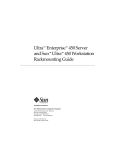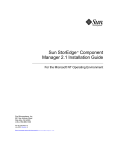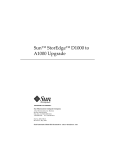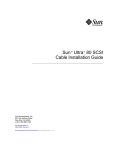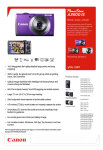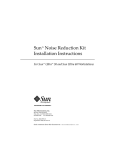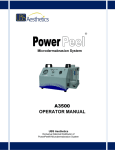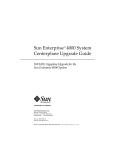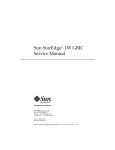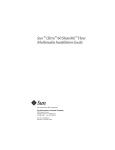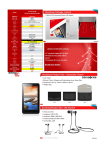Download Sun Microsystems A3500 User's Manual
Transcript
Sun™ StorEdge™ A3500 Hardware Configuration Guide Sun Microsystems, Inc. 901 San Antonio Road Palo Alto, CA 94303-4900 USA 650 960-1300 Fax 650 969-9131 Part No. 805-4981-11 September 1998, Revision A Send comments about this document to: [email protected] Copyright 1998 Sun Microsystems, Inc., 901 San Antonio Road • Palo Alto, CA 94303 USA. All rights reserved. Portions copyright 1997 Symbios Logic, Inc. All rights reserved. This product or document is protected by copyright and distributed under licenses restricting its use, copying, distribution, and decompilation. No part of this product or document may be reproduced in any form by any means without prior written authorization of Sun and its licensors, if any. Third-party software, including font technology, is copyrighted and licensed from Sun suppliers. Parts of the product may be derived from Berkeley BSD systems, licensed from the University of California. UNIX is a registered trademark in the U.S. and other countries, exclusively licensed through X/Open Company, Ltd. Sun, Sun Microsystems, the Sun logo, AnswerBook, StorEdge, and Solaris are trademarks, registered trademarks, or service marks of Sun Microsystems, Inc. in the U.S. and other countries. All SPARC trademarks are used under license and are trademarks or registered trademarks of SPARC International, Inc. in the U.S. and other countries. Products bearing SPARC trademarks are based upon an architecture developed by Sun Microsystems, Inc. The OPEN LOOK and Sun™ Graphical User Interface was developed by Sun Microsystems, Inc. for its users and licensees. Sun acknowledges the pioneering efforts of Xerox in researching and developing the concept of visual or graphical user interfaces for the computer industry. Sun holds a non-exclusive license from Xerox to the Xerox Graphical User Interface, which license also covers Sun’s licensees who implement OPEN LOOK GUIs and otherwise comply with Sun’s written license agreements. RESTRICTED RIGHTS: Use, duplication, or disclosure by the U.S. Government is subject to restrictions of FAR 52.227-14(g)(2)(6/87) and FAR 52.227-19(6/87), or DFAR 252.227-7015(b)(6/95) and DFAR 227.7202-3(a). DOCUMENTATION IS PROVIDED “AS IS” AND ALL EXPRESS OR IMPLIED CONDITIONS, REPRESENTATIONS AND WARRANTIES, INCLUDING ANY IMPLIED WARRANTY OF MERCHANTABILITY, FITNESS FOR A PARTICULAR PURPOSE OR NONINFRINGEMENT, ARE DISCLAIMED, EXCEPT TO THE EXTENT THAT SUCH DISCLAIMERS ARE HELD TO BE LEGALLY INVALID. Copyright 1998 Sun Microsystems, Inc., 901 San Antonio Road • Palo Alto, CA 94303 Etats-Unis. Tous droits réservés. Des portions de ce produit sont protégées par un copyright (1997) de Symbios Logic, Inc. Tous droits réservés. Ce produit ou document est protégé par un copyright et distribué avec des licences qui en restreignent l’utilisation, la copie, la distribution, et la décompilation. Aucune partie de ce produit ou document ne peut être reproduite sous aucune forme, par quelque moyen que ce soit, sans l’autorisation préalable et écrite de Sun et de ses bailleurs de licence, s’il y en a. Le logiciel détenu par des tiers, et qui comprend la technologie relative aux polices de caractères, est protégé par un copyright et licencié par des fournisseurs de Sun. Des parties de ce produit pourront être dérivées des systèmes Berkeley BSD licenciés par l’Université de Californie. UNIX est une marque déposée aux Etats-Unis et dans d’autres pays et licenciée exclusivement par X/Open Company, Ltd. Sun, Sun Microsystems, le logo Sun, AnswerBook,StorEdge, et Solaris sont des marques de fabrique ou des marques déposées, ou marques de service, de Sun Microsystems, Inc. aux Etats-Unis et dans d’autres pays. Toutes les marques SPARC sont utilisées sous licence et sont des marques de fabrique ou des marques déposées de SPARC International, Inc. aux Etats-Unis et dans d’autres pays. Les produits portant les marques SPARC sont basés sur une architecture développée par Sun Microsystems, Inc. L’interface d’utilisation graphique OPEN LOOK et Sun™ a été développée par Sun Microsystems, Inc. pour ses utilisateurs et licenciés. Sun reconnaît les efforts de pionniers de Xerox pour la recherche et le développement du concept des interfaces d’utilisation visuelle ou graphique pour l’industrie de l’informatique. Sun détient une licence non exclusive de Xerox sur l’interface d’utilisation graphique Xerox, cette licence couvrant également les licenciés de Sun qui mettent en place l’interface d’utilisation graphique OPEN LOOK et qui en outre se conforment aux licences écrites de Sun. CETTE PUBLICATION EST FOURNIE "EN L’ETAT" ET AUCUNE GARANTIE, EXPRESSE OU IMPLICITE, N’EST ACCORDEE, Y COMPRIS DES GARANTIES CONCERNANT LA VALEUR MARCHANDE, L’APTITUDE DE LA PUBLICATION A REPONDRE A UNE UTILISATION PARTICULIERE, OU LE FAIT QU’ELLE NE SOIT PAS CONTREFAISANTE DE PRODUIT DE TIERS. CE DENI DE GARANTIE NE S’APPLIQUERAIT PAS, DANS LA MESURE OU IL SERAIT TENU JURIDIQUEMENT NUL ET NON AVENU. Contents Preface 1. Host Connections 1-1 1.1 Configuration Guidelines 1.2 Supported Host Configurations 1.3 2. v 1.2.1 Single Host 1.2.2 Daisy Chain 1.2.3 Independent Controller 1.2.4 Multi-Initiator 2.2 2.3 1-3 1-3 1-4 1-5 1-6 Ultra 2 Host System—Power Connection Requirement StorEdge A3500 Configurations 2.1 1-2 2-1 StorEdge D1000 Disk Array Settings 2.1.1 1x2 Configuration 2-3 2.1.2 1x5 Configuration 2-5 2.1.3 2x7 Configuration 2-7 2.1.4 3x15 Configuration 1x2 Cabling 2-2 2-9 2-11 2.2.1 SCSI Cabling 2.2.2 Power Connections 1x5 Cabling 1-7 2-11 2-13 2-14 Contents iii 2.4 2.5 iv 2.3.1 SCSI Cabling 2.3.2 Power Connections 2x7 Cabling 2-14 2-17 2.4.1 SCSI Cabling 2.4.2 Power Connections 3x15 Cabling 2-16 2-17 2-19 2-20 2.5.1 SCSI Cabling 2-21 2.5.2 Power Connections 2.5.3 Connecting to AC Power Source 2.5.4 Power Connections 2-25 2-26 Sun StorEdge A3500 Hardware Configuration Guide • September 1998 2-25 Preface Sun StorEdge A3500 Hardware Configuration Guide provides configuration instructions for the Sun™ StorEdge™ A3500 systems. These instructions are designed for an experienced system administrator. Using UNIX Commands This document does not contain information on basic UNIX® commands and procedures such as shutting down the system, booting the system, and configuring devices. See one or more of the following for this information: ■ Solaris 2.x Handbook for SMCC Peripherals ■ AnswerBook™ online documentation for the Solaris™ 2.x software environment ■ Other software documentation that you received with your system v Typographic Conventions TABLE P-1 Typographic Conventions Typeface or Symbol Meaning Examples AaBbCc123 The names of commands, files, and directories; on-screen computer output. Edit your .login file. Use ls -a to list all files. % You have mail. AaBbCc123 What you type, when contrasted with on-screen computer output. % su Password: AaBbCc123 Book titles, new words or terms, words to be emphasized. Command-line variable; replace with a real name or value. Read Chapter 6 in the User’s Guide. These are called class options. You must be root to do this. To delete a file, type rm filename. Shell Prompts TABLE P-2 vi Shell Prompts Shell Prompt C shell machine_name% C shell superuser machine_name# Bourne shell and Korn shell $ Bourne shell and Korn shell superuser # Sun StorEdge A3500 Hardware Configuration Guide • September 1998 Related Documentation TABLE P-3 Related Documentation Title Part Number Sun StorEdge A3000 Controller Module Guide 805-4980-xx Sun StorEdge A3500 Task Map 805-4982-xx Sun Documentation on the Web The docs.sun.comsm web site enables you to access Sun technical documentation on the Web. You can browse the docs.sun.com archive or search for a specific book title or subject at: http://docs.sun.com Sun Welcomes Your Comments We are interested in improving our documentation and welcome your comments and suggestions. You can email your comments to us at: [email protected] Please include the part number of your document in the subject line of your email. vii viii Sun StorEdge A3500 Hardware Configuration Guide • September 1998 CHAPTER 1 Host Connections This chapter contains configurations for one or two Sun StorEdge A3000 controller modules connected to one or more hosts. It also contains information about connecting power to an Ultra™ host system. ■ ■ ■ Configuration Guidelines—page 1-2 Supported Host Configurations—page 1-3 ■ Single Host—page 1-3 ■ Daisy Chain—page 1-4 ■ Independent Controller—page 1-5 ■ Multi-Initiator—page 1-6 Ultra 2 Host System—Power Connection Requirement—page 1-7 1-1 1.1 Configuration Guidelines Use the following guidelines for installing and cabling or reconfiguring your system. ■ Do not exceed a SCSI bus length of 25 meters. ■ Make sure that the last Sun StorEdge A3000 controller module in any daisy chain has a total of two terminators, one in each SCSI OUT port. ■ If you are adding a controller module to an already existing configuration, halt all activity on the SCSI bus before removing any SCSI cables. ■ Once you finish cabling the devices and powering on, reboot the system by typing boot -r at the ok prompt before beginning any SCSI bus activity. Perform a system check to make sure that SCSI connections are secure. Look for fault LEDs on the hardware or error messages in the RAID Manager GUI. Note – Refer to your server and rack documentation for instructions on grounding the StorEdge A3500 cabinet. 1-2 Sun StorEdge A3500 Hardware Configuration Guide • September 1998 1.2 Supported Host Configurations The examples that follow show the cable connections for configurations that are supported by Sun Microsystems™. 1.2.1 Single Host Differential SCSI terminators FIGURE 1-1 Single Host Connected to a Sun StorEdge A3000 Controller Module Chapter 1 Host Connections 1-3 1.2.2 Daisy Chain You can daisy chain controller modules in the same or separate cabinets. SCSI cables FIGURE 1-2 Differential SCSI terminators Two Sun StorEdge A3000 Controller Modules Daisy Chained to One Host Note – The SCSI cables between the two controller modules are crossed to prevent the SCSI IDs for the controllers from conflicting. 1-4 Sun StorEdge A3500 Hardware Configuration Guide • September 1998 1.2.3 Independent Controller Differential SCSI terminators FIGURE 1-3 Independent Controller—One Sun StorEdge A3000 Controller Connected to Two Hosts Chapter 1 Host Connections 1-5 1.2.4 Multi-Initiator FIGURE 1-4 Two-Node Multi-Initiator Configuration Note – For more detailed information regarding the two-node multi-initiator configuration, such as setting host SCSI IDs, refer to the SPARCcluster™ PDB™ documentation that is shipped with the host system. 1-6 Sun StorEdge A3500 Hardware Configuration Guide • September 1998 1.3 Ultra 2 Host System—Power Connection Requirement You can connect a controller module to an Ultra 2 host system; however, you must connect the power cord of the Ultra 2 host to one of the AC power sequencers in the expansion cabinet that contains the controller module. You need to order one of the following power cords depending on the type of power sequencer in the expansion cabinet (FIGURE 1-5): ■ ■ Ultra™ Enterprise™ expansion cabinet and StorEdge expansion cabinet— part number 530-2197-xx 56-Inch Data Center expansion cabinet—part number 180-1189-xx (United States) or part number 180-1190-xx NEMA (European) Caution – Failure to connect the power cord correctly as described here may cause excessive ground current that could damage the system. Plug in Ultra 2 power cord here Ultra Enterprise expansion cabinet and StorEdge expansion cabinet power sequencer FIGURE 1-5 56-inch data center expansion cabinet power sequencer AC Power Sequencers—Ultra 2 Power Connector Chapter 1 Host Connections 1-7 1. Gain access to the AC power sequencers. See the documentation that came with the expansion cabinet. 2. Route the power cable from the Ultra 2 host under the expansion cabinet frame on the same side as the power sequencer. 3. Plug the power cord from the Ultra 2 host into the top power connector of either power sequencer (FIGURE 1-5). The power connectors are located on the other side of the power sequencer from the main switch. 4. Reassemble the expansion cabinet. See the documentation that came with the expansion cabinet. 1-8 Sun StorEdge A3500 Hardware Configuration Guide • September 1998 CHAPTER 2 StorEdge A3500 Configurations This chapter contains information about setting up the following configurations: ■ ■ ■ ■ One controller module with two StorEdge D1000 disk arrays (1x2) One controller module with five StorEdge D1000 disk arrays (1x5) Two controller modules with seven StorEdge D1000 disk arrays (2x7) Three controller modules with fifteen StorEdge D1000 disk arrays (3x15) The chapter is divided into the following sections: ■ StorEdge D1000 Disk Array Settings—page 2-2 ■ 1x2 Configuration—page 2-3 ■ 1x5 Configuration—page 2-5 ■ 2x7 Configuration—page 2-7 ■ 3x15 Configuration—page 2-9 ■ 1x2 Cabling—page 2-11 ■ SCSI Cabling—page 2-11 ■ Power Connections—page 2-13 ■ 1x5 Cabling—page 2-14 ■ SCSI Cabling—page 2-14 ■ Power Connections—page 2-16 2x7 Cabling—page 2-17 ■ SCSI Cabling—page 2-17 ■ Power Connections—page 2-19 3x15 Cabling—page 2-20 ■ SCSI Cabling—page 2-21 ■ Power Connections—page 2-25 ■ ■ 2-1 2.1 StorEdge D1000 Disk Array Settings This section describes how to set the following attributes for StorEdge D1000 disk arrays (FIGURE 2-1) in 1x2, 1x5, 2x7, and 3x15 configurations: ■ ■ ■ Option switch Module ID SCSI jumper cables and terminators Option Switch Module ID IN/OUT-1 IN/OUT-1 IN/OUT -2 Rear FIGURE 2-1 2-2 StorEdge D1000 Disk Array Sun StorEdge A3500 Hardware Configuration Guide • September 1998 IN/OUT -2 2.1.1 1x2 Configuration 2.1.1.1 Option Switch Both disk arrays have split busses. Their option switches should be set as shown in FIGURE 2-2. 5 4 3 FIGURE 2-2 2 1 1x2 Option Switch Settings for StorEdge D1000 Disk Array This will cause the disk drives in the StorEdge D1000 disk arrays to be numbered as shown in FIGURE 2-3 and FIGURE 2-4. 0 1 FIGURE 2-3 0 1 FIGURE 2-4 2 3 0 1 2 3 8-drive StorEdge D1000 SCSI ID (Split bus) 2 3 4 5 0 1 2 3 4 5 12-drive StorEdge D1000 SCSI Disk ID (Split bus) Chapter 2 StorEdge A3500 Configurations 2-3 2.1.1.2 Module ID Switch Ensure that the module IDs for the StorEdge D1000 disk arrays are set according to . 1x2 Module ID Switch Settings Disk array number Module ID setting 2 (Top) 2 1 (Bottom) 1 Note – Since the top and bottom disk arrays are split between one controller module, the Module IDs will overlap. This may result in error messages while the host system is booting. The ASC/ASCQ codes for this error is 98/01 and the Sense Key is 6. These error messages are information only and will not impact system performance. 2.1.1.3 SCSI Jumper Cables and Terminators The disk arrays should have differential SCSI terminators on the inside IN/OUT-1 and IN/OUT-2 SCSI connectors. This configuration is shown in FIGURE 2-11 2-4 Sun StorEdge A3500 Hardware Configuration Guide • September 1998 2.1.2 1x5 Configuration 2.1.2.1 Option Switch All StorEdge D1000 disk arrays in this configuration should have their option switches set as shown in FIGURE 2-5. 5 4 3 FIGURE 2-5 2 1 1x5 Option Switch Settings for StorEdge D1000 Disk Array This will cause the disk drives in the StorEdge D1000 disk arrays to be numbered as shown in FIGURE 2-6 and FIGURE 2-7. 0 1 FIGURE 2-6 0 1 FIGURE 2-7 2 3 8 9 10 11 8-drive StorEdge D1000 SCSI ID (Single Bus) 2 3 4 5 8 9 10 11 12 13 12-drive StorEdge D1000 SCSI ID (Single Bus) Chapter 2 StorEdge A3500 Configurations 2-5 2.1.2.2 Module ID Switch Ensure that the module IDs for the StorEdge D1000 disk arrays are set according to TABLE 2-1. TABLE 2-1 2.1.2.3 1x5 Module ID Switch Settings Disk array number Module ID setting 5 (Top) 5 4 4 3 3 2 2 1 (Bottom) 1 SCSI Jumper Cables and Terminators All disk arrays in this configuration should have SCSI jumper cables between the middle SCSI connectors (IN/OUT-1 and IN/OUT-2) and a differential SCSI terminator in the far right SCSI connector (IN/OUT-2). This configuration is shown in FIGURE 2-15. 2-6 Sun StorEdge A3500 Hardware Configuration Guide • September 1998 2.1.3 2x7 Configuration 2.1.3.1 Option Switch The disk drives in each of the top four disk arrays in FIGURE 2-17 are on a single bus and should be set as described in Section 2.1.2.1 “Option Switch” on page 2-5. The bottom three disk arrays have split busses. Their option switches should be set as shown in FIGURE 2-8. 5 4 3 FIGURE 2-8 2 1 2x7 Option Switch Settings for StorEdge D1000 Disk Array This will cause the disk drives in the StorEdge D1000 disk arrays to be numbered as shown in FIGURE 2-9 and FIGURE 2-10. 0 1 FIGURE 2-9 0 1 FIGURE 2-10 2 3 0 1 2 3 8-drive StorEdge D1000 SCSI ID (Split bus) 2 3 4 5 0 1 2 3 4 5 12-drive StorEdge D1000 SCSI Disk ID (Split bus) Chapter 2 StorEdge A3500 Configurations 2-7 2.1.3.2 Module ID Switch Ensure that the module IDs for the StorEdge D1000 disk arrays are set according to TABLE 2-2. TABLE 2-2 2x7 Module ID Switch Settings Disk array number Module ID setting 7 (Top) 5 6 4 5 5 4 4 3 3 2 2 1 (Bottom) 1 Facing the front of the expansion cabinet: ■ controller module A controls the right side of disk arrays 1 through 3 and all of disk arrays 4 and 5. ■ controller module B controls the left side of disk arrays 1 through 3 and all of disk arrays 6 and 7. This configuration is shown in FIGURE 2-17. 2.1.3.3 SCSI Jumper Cables and Terminators The top four disk arrays should have SCSI jumper cables between the middle SCSI connectors (IN/OUT-1 and IN/OUT-2) and a differential SCSI terminator in the far right SCSI connector (IN/OUT-2). The bottom three disk arrays should have differential SCSI terminators on the inside IN/OUT-1 and IN/OUT-2 SCSI connectors. This configuration is shown in FIGURE 2-17. 2-8 Sun StorEdge A3500 Hardware Configuration Guide • September 1998 2.1.4 3x15 Configuration 2.1.4.1 Option Switch All disk arrays are on a single bus and should be set as described in Section 2.1.2.1 “Option Switch” on page 2-5. 2.1.4.2 Module ID Switch Ensure that the module IDs for the StorEdge D1000 disk arrays are set according to TABLE 2-3 and TABLE 2-4. TABLE 2-3 3x15 Module ID Switch Settings 2x7 Disk array number Module ID setting 7 (Top) 5 6 4 5 3 4 2 3 1 2 1 1 (Bottom) 2 TABLE 2-4 3x15 Module ID Switch Settings 1x8 Disk array number Module ID setting 8 (Top) 5 7 4 6 3 5 2 4 1 3 5 2 4 1 (Bottom) 3 Chapter 2 StorEdge A3500 Configurations 2-9 In this configuration: 2.1.4.3 ■ controller module A controls disk arrays 1 and 2 in the 2x7 cabinet and disk arrays 1 through 3 in 1x8 cabinet (FIGURE 2-19) ■ controller module B controls disk arrays 3 through 7 in 2x7 cabinet (FIGURE 2-20) ■ controller module C controls disk arrays 4 through 8 in 1x8 cabinet (FIGURE 2-21) SCSI Jumper Cables and Terminators All disk arrays in this configuration should have SCSI jumper cables between the middle SCSI connectors (IN/OUT-1 and IN/OUT-2) and a differential SCSI terminator in the far right SCSI connector (IN/OUT-2). 2-10 Sun StorEdge A3500 Hardware Configuration Guide • September 1998 2.2 1x2 Cabling The 1x2 can be configured with the controller module either on top of or below the two disk arrays. Both configurations are described in this section. 2.2.1 SCSI Cabling 2.2.1.1 Cable Lengths The following table shows the lengths of each SCSI cable connected to the drive connections on the controller module. TABLE 2-5 Controller Module A (1x2) SCSI Port Number Cable Length Part Number 1 .8m 530-1884-xx 2 .8m 530-1884-xx 3 .8m 530-1884-xx 4 .8m 530-1884-xx 5 Differential SCSI terminator 150-1890-xx The inboard IN/OUT connectors on each disk array are terminated with a differential SCSI terminator, part number 150-1890-xx. Chapter 2 StorEdge A3500 Configurations 2-11 2.2.1.2 SCSI Connections Differential SCSI terminator 2 1 Differential SCSI terminator FIGURE 2-11 Differential SCSI terminator One A3000 Controller Module and Two D1000 Disk Arrays (SCSI) Differential SCSI terminator Differential SCSI terminator 2 1 Differential SCSI terminator FIGURE 2-12 2-12 Two D1000 Disk Arrays and One A3000 Controller Module (SCSI) Sun StorEdge A3500 Hardware Configuration Guide • September 1998 2.2.2 Power Connections Because the controller module must receive power after the disk arrays, connect the disk arrays to the first stage of the power sequencer and the controller module to the second. Two examples are shown below. Front sequencer R3 R1&R2 R3 L1&L2 L3 L3 L2 R2 L1 Rear view FIGURE 2-13 Rear sequencer R1 One A3000 Controller Module and Two D1000 Disk Arrays (Power) R6 R4 Front sequencer L6 R5 R6 L6 L5 L4 R5 Rear view R4 Rear sequencer L4 L5 FIGURE 2-14 Two D1000 Disk Arrays and One A3000 Controller Module (Power) Chapter 2 StorEdge A3500 Configurations 2-13 2.3 1x5 Cabling 2.3.1 SCSI Cabling 2.3.1.1 Cable Lengths The following table shows the lengths of each SCSI cable connected to the drive connections on the controller module. TABLE 2-6 Controller Module A (1x5) SCSI Port Number Cable Length Part Number 1 2m 530-1885-xx 2 2m 530-1885-xx 3 2m 530-1885-xx 4 2m 530-1885-xx 5 2m 530-1885-xx The inboard IN/OUT connectors on each of the disk arrays are connected together using a 0.2m SCSI jumper cable, part number 530-1883-xx. The outboard IN/OUT-2 connector on each disk array is terminated with a differential SCSI terminator, part number 150-1890-xx. 2-14 Sun StorEdge A3500 Hardware Configuration Guide • September 1998 2.3.1.2 SCSI Connections 5 4 3 2 1 Differential SCSI terminator SCSI jumper cable FIGURE 2-15 One A3000 Controller Module and Five D1000 Disk Arrays (SCSI) Chapter 2 StorEdge A3500 Configurations 2-15 2.3.2 Power Connections R5 L5 L6 R6 L4 R4 L3 R3 L2 R2 L1 Rear view R6 R4 R1&R2 R3 L6 L4 L1&L2 L3 R1 Front sequencer R5 Rear sequencer FIGURE 2-16 2-16 One A3000 Controller Module and Five D1000 Disk Arrays (Power) Sun StorEdge A3500 Hardware Configuration Guide • September 1998 L5 2.4 2x7 Cabling 2.4.1 SCSI Cabling 2.4.1.1 Cable Lengths The following tables show the lengths of each SCSI cable connected to the drive connections on the respective controller modules. TABLE 2-7 Controller Module A (2x7) SCSI Port Number Cable Length Part Number 1 .8m 530-1884-xx 2 .8m 530-1884-xx 3 .8m 530-1884-xx 4 2m 530-1885-xx 5 2m 530-1885-xx TABLE 2-8 Controller Module B (2x7) SCSI Port Number Cable Length Part Number 1 2m 530-1885-xx 2 .8m 530-1884-xx 3 .8m 530-1884-xx 4 2m 530-1885-xx 5 2m 530-1885-xx The inboard IN/OUT connectors on each of the top four disk arrays are connected together using a 0.2m SCSI jumper cable, part number 530-1883-xx. The inboard IN/OUT connectors on the bottom three disk arrays are terminated with differential SCSI terminators, part number 150-1890-xx. Chapter 2 StorEdge A3500 Configurations 2-17 2.4.1.2 SCSI Connections B5 B4 Differential SCSI terminator A5 SCSI jumper cable A4 A3 B3 Differential SCSI terminators A2 A1 Controller Module A FIGURE 2-17 2-18 B2 Controller Module B Two A3000 Controller Modules and Seven D1000 Disk Arrays (SCSI) Sun StorEdge A3500 Hardware Configuration Guide • September 1998 B1 2.4.2 Power Connections L9 R9 L8 R8 L7 R7 L6 R6 R5 L5 R8 R4 R9 R1&R2 R7 R3 R5 L6 L8 L4 L9 L1&L2 L7 L3 L5 R6 R4 Front sequencer L4 R3 L3 L2 R2 L1 R1 Rear sequencer Rear view FIGURE 2-18 Two A3000 Controller Modules and Seven D1000 Disk Arrays (Power) Chapter 2 StorEdge A3500 Configurations 2-19 2.5 3x15 Cabling This section contains information about SCSI and power connections for three StorEdge A3000 controller modules and fifteen StorEdge D1000 disk arrays in two StorEdge expansion cabinets. Caution – The components in the expansion cabinets are configured as a single unit. Make sure that the serial numbers on each expansion cabinet match. 2-20 Sun StorEdge A3500 Hardware Configuration Guide • September 1998 2.5.1 SCSI Cabling 2.5.1.1 Cable Lengths The following tables show the lengths of each SCSI cable connected to the drive connections on the respective controller modules. TABLE 2-9 Controller Module A (3x15) SCSI Port Number Cable Length Part Number 1 .8m 530-1884-xx 2 .8m 530-1884-xx 3 4m 530-2352-xx 4 4m 530-2352-xx 5 4m 530-2352-xx TABLE 2-10 Controller Module B (3x15) SCSI Port Number Cable Length Part Number 1 .8m 530-1884-xx 2 .8m 530-1884-xx 3 2m 530-1885-xx 4 2m 530-1885-xx 5 2m 530-1885-xx TABLE 2-11 Controller Module C (3x15) SCSI Port Number Cable Length Part Number 1 .8m 530-1884-xx 2 .8m 530-1884-xx 3 2m 530-1885-xx 4 2m 530-1885-xx 5 2m 530-1885-xx The inboard IN/OUT connectors on each of the disk arrays are connected together using a 0.2m SCSI jumper cable, part number 530-1883-xx. Chapter 2 StorEdge A3500 Configurations 2-21 The outboard IN/OUT-2 connector on each disk array is terminated with a differential SCSI terminator, part number 150-1890-xx. 2.5.1.2 SCSI Connections for Controller Module A A5 Differential SCSI terminator A1 A4 SCSI jumper cable A2 2x7 FIGURE 2-19 2-22 1x8 3x15 (Controller Module A) Sun StorEdge A3500 Hardware Configuration Guide • September 1998 A3 2.5.1.3 SCSI Connections for Controller Module B B5 Differential SCSI terminator B4 SCSI jumper cable B3 B2 B1 2x7 FIGURE 2-20 1x8 3x15 (Controller Module B) Chapter 2 StorEdge A3500 Configurations 2-23 2.5.1.4 SCSI Connections for Controller Module C C5 SCSI jumper cable C4 Differential SCSI terminator C3 C2 C1 2x7 FIGURE 2-21 2-24 1x8 3x15 (Controller Module C) Sun StorEdge A3500 Hardware Configuration Guide • September 1998 2.5.2 Power Connections 2.5.2.1 Power Sequencer Interconnections The front and rear power sequencers in the 2x7 cabinet and the 1x8 cabinet must be interconnected. Make sure an interconnect cable (part number 530-2235-xx) is connected between the OUT on the front sequencer in 2x7 cabinet and the IN on the front sequencer in 1x8 cabinet (FIGURE 2-22). Make sure that the rear sequencers are likewise connected. FIGURE 2-22 2.5.3 Connecting the Power Sequencers Connecting to AC Power Source Each of the AC power cords connected to the expansion cabinets should be on independent circuit breakers. To ensure proper redundancy, if independent circuit breaker boxes or AC power sources are used, power cords from the same expansion cabinet should be connected to different circuit breaker boxes or AC power sources. Caution – You must ensure that the second rack will not lose power without the first. Data loss is likely to occur if this happens. DO NOT configure the 3x15 expansion cabinets as shown in FIGURE 2-23 and FIGURE 2-24. Consult with an electrician if you do not understand the schematics in the figures. Chapter 2 StorEdge A3500 Configurations 2-25 2x7 Phase A FIGURE 2-23 2x7 1x8 Phase B Power Connections to Avoid (Different Phases) 1x8 Same phase AC FIGURE 2-24 2.5.4 Power Connections to Avoid (Same Phase) Power Connections The power connections for 2x7 cabinet are the same as those in the standard 2x7 expansion cabinet (FIGURE 2-18). 2-26 Sun StorEdge A3500 Hardware Configuration Guide • September 1998 The power connections for the 1x8 cabinet are shown in FIGURE 2-25. L9 R9 L8 R8 L7 R7 L6 R6 L5 R3 R4 R9 R1&R2 R7 R8 R5 L6 L3 L4 L9 L1&L2 L7 L8 L5 R6 R5 R4 Front sequencer L4 L3 R3 L2 R2 L1 R1 Rear sequencer Rear view FIGURE 2-25 One A3000 Controller Modules and Eight D1000 Disk Arrays (Power) Chapter 2 StorEdge A3500 Configurations 2-27 2-28 Sun StorEdge A3500 Hardware Configuration Guide • September 1998














































